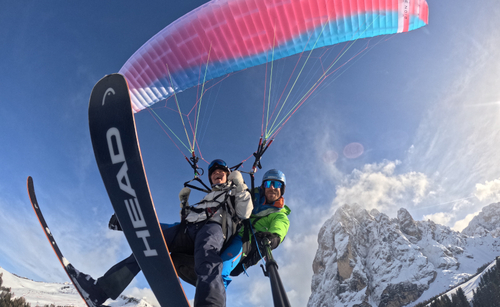
Starten und Landen - einfach und sicher. Ein zuverlässiges Startverhalten ist die Grundvoraussetzung für einen reibungslosen und entspannten Tandem-Flug. Der BION 3 steigt in verschiedensten Gelände- und Windbedingungen spurtreu und verlässlich über den Piloten und besticht durch geringe Abhebegeschwindigkeit. Am Ende des Fluges ermöglichen die großen Flare-Reserven eine sichere und sanfte Landung, auch bei Windstille.
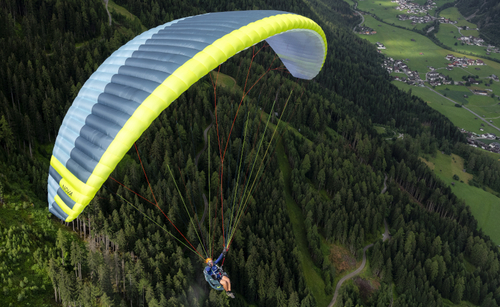
Top Flugeigenschaften. Ein Tandem muss – wie kein anderer Schirm – innerhalb eines großen Gewichtsbereichs funktionieren: Der BION3 ist mit geringer Beladung agil und bietet einen großen Geschwindigkeitszuwachs, wobei die hohe Stabilität erhalten bleibt. Mit hoher Flächenbelastung bleibt der Bremsdruck moderat und die Minimalgeschwindigkeit bei Start und Landung ist angenehm gering. Der BION3 funktioniert im gesamten Gewichtsspektrum ohne Kompromisse.
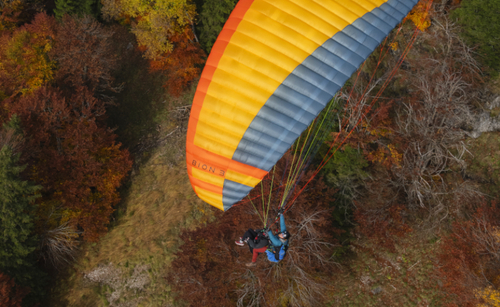
Intelligent Lightweight: Leicht, haltbar, alltagstauglich. Entwickelt nach dem Leitspruch »so leicht wie möglich, und so stabil wie nötig«, setzen wir auf eine intelligente Konstruktion und Materialwahl. Nach Möglichkeit verwenden wir Leichtmaterial und an stärker beanspruchten Stellen die stabilere Tuchvariante. So können wir lange Haltbarkeit, hohe Leistung und einfaches Handling bei niedrigem Gewicht gewährleisten. Die Gleitschirme sind leicht, voll alltagstauglich UND haltbar.
Zielgruppe des BION 3
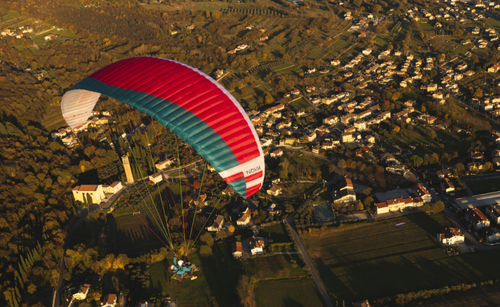
Der BION 3 richtet sich an ein breites Pilotenspektrum. Auf der einen Seite steht der gewerbliche Tandempilot, der an einem einfachen Handling, einem zuverlässigen Start-, und Landeverhalten und an langer Lebensdauer interessiert ist. Auf der anderen Seite steht der Genusspilot, der einen leistungsstarken Schirm sucht, mit dem er sicher und entspannt auch ausgedehnte Thermikflüge unternehmen kann. Beide Pilotengruppen werden das ausgewogene Handling, die Geschwindigkeit und die Gleitleistung des BION 3 schätzen.Das neue Profil zeichnet sich durch ausgezeichnetes Thermik-Handling bei geschlossenen Trimmern aus. Bei offenen Trimmern bietet der BION 2 außergewöhnlich hohe Geschwindigkeit bei guter Gleitleistung.
Statement
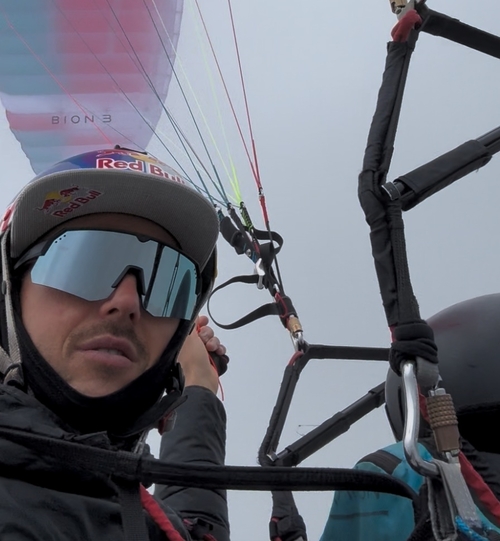
Aaron Durogati:
"Meiner Meinung nach ist der BION 3 ein fantastischer Tandemschirm für den professionellen Einsatz. Starts und Landungen sind super einfach, so wie es bei einem Tandemschirm sein sollte. Und in der Luft ist der Bremsdruck leicht und angenehm, auch wenn man in der Thermik kreist."
Alles im Griff.

Der 20 mm breite BION 3 Riser verfügt über Fidlock-Magnetschnallen, mit denen Bremsgriff und Trimmergurt schnell und praktisch fixiert werden können. Eine Klemme zur stufenlosen Fixierung der A3-Stammleine ermöglicht das anstrengungsfreie Halten von Big Ears. Das geringe Gewicht und das kompakte Packmaß des BION 3 erleichtern den Arbeitsalltag beim kommerziellen Fliegen beträchtlich. Apropos Erleichterung: Der Schirm kommt in einem großen und schlichten Packsack, der genug Platz für lockeres und schnelles Packen bietet.
Technische Daten
| L | ||
|---|---|---|
| Zellenzahl | 51 | |
| Projizierte Spannweite | m | 11,67 |
| Projizierte Fläche | m² | 34,5 |
| Projizierte Streckung | 3,95 | |
| Ausgelegte Spannweite | m | 14,69 |
| Ausgelegte Fläche | m² | 40,68 |
| Ausgelegte Streckung | 5,30 | |
| Distance pilot-glider | m | 8,86 |
| Max. Profiltiefe | m | 3,49 |
| Min. Profiltiefe | m | 0,68 |
| Gewicht | kg | 6,8 |
| Zugelassener Gewichtsbereich | kg | 110-220 |
| Certified take off weight Motor DGAC | kg | 110-250 |
| Certification (EN/LTF) | B (DHV GS-01-2972-25) |
FAQ
Die Bremse ist ein zulassungsrelevantes Bauteil – Veränderungen können sich auf die Flugeigenschaften und auf Extremflugmanöver auswirken. Unter diesem Aspekt raten wir von Veränderungen dringend ab. Wichtig ist, dass die Bremse ausreichend Leerweg aufweist, ehe sie greift. Dies ist wichtig, damit der Schirm beim Beschleunigen nicht von selbst zu bremsen beginnt. Darüber hinaus kostet eine Bremse mit Vorbremsung Leistung und beeinflusst die Ausleitung von Kappenstörungen, etwa die Öffnung von Klappern oder die Ausleitung eines Sackflugs.
Die Leistungsdaten hängen stark vom Widerstand des Piloten und damit verknüpft mit dessen Sitzhaltung und verwendetem Gurtzeug ab. Der Unterschied zwischen strömungstechnisch guten und weniger guten Gurtzeugen, beziehungsweise Sitzpositionen kann eine Gleitzahl oder mehr betragen. Wir selbst ermitteln nie absolute Leistungsdaten sondern vergleichen mit Referenzschirmen. Aus diesen Gründen veröffentlichen wir keine Leistungsdaten.
Wie man die Bremse hält, ist eine Frage persönlicher Präferenzen – die Haltung wirkt sich jedoch markant auf das Handling und die Flugeigenschaften aus. Wir von NOVA empfehlen eine halbe Wicklung: Man nimmt den Bremsgriff dazu in die Handfläche und wickelt die Bremsleine in einer halben Umdrehung um die Hand, sodass die Bremsleine den Handschuh zwischen Daumen und Zeigefinger wieder verlässt. Dies verkürzt den Bremsweg um rund 20 Zentimeter, was sich positiv auf das Feedback auswirkt: Einerseits spürt man so den direkten Zug der Bremsleine; andererseits fühlt man in dieser höheren Armstellung besser die Reaktionen, die der Schirm vermittelt. Vom Bremsen ohne Wickeln raten wir der schlechteren Ergonomie wegen ab. Ausgenommen davon sind natürlich Gleitstrecken oder andere Flugphasen, bei denen ein direktes Handling über die Bremse nicht von Bedeutung ist. Achtung: Wer von ungewickelt auf eine halbe Wicklung umstellt, muss den verkürzten Bremsweg mit einberechnen.
Einfachheit ist unser Grundsatz. Unsere Schirme können, müssen jedoch nicht in einem Zellpacksack verstaut werden. Diesen Schirm kannst du mit deiner bevorzugten Methode zusammenlegen und in unseren Stuffsack packen. Achte darauf, die Stäbchen an der Eintrittskante nicht unnötig stark zu knicken. Dies gilt vor allem bei längerer Lagerung und engem Packen.
Tücher, Leinen und alle weiteren Bestandteile werden intensiven Erprobungstests unterzogen, bevor wir sie in der Serienproduktion verwenden. Wir testen die Tücher nicht nur auf Alterungsbeständigkeit (höhere Porosität oder verringerte Reißfestigkeit durch UV-Strahlung oder Abrieb), sondern auch auf mechanische Stabilität, etwa auf Dehnung. Zur Qualitätssicherung nehmen wir auch während der Serienproduktion regelmäßig Stichproben.
Bei den ersten Flügen werden neue Leinen erstmals einer Belastung ausgesetzt. Durch diese Belastung kommt es zu leichten Dehnungen und Schrumpfungen. Diese stehen nicht im Zusammenhang mit dem Hersteller der Leinen oder der Verarbeitungsqualität – ab Werk sind alle NOVA-Gleitschirme innerhalb sehr geringer Toleranzen getrimmt und vorgedehnt. Zum Ausgleich dieses Dehnens beziehungsweise Schrumpfens empfehlen wir, den Schirm bereits nach 10 bis 20 Flugstunden zum NTT (NOVA Trim Tuning) zu bringen – allerspätestens nach einem Jahr. Nach den ersten 10 bis 20 Stunden bleiben die Leinenlängen in der Regel jedoch weitgehend konstant. Zur Ausschöpfung des vollen Nutzens des NTT ist seitens NOVA jeder Pilot angehalten, seinen Schirm nach 10 bis 20 Flugstunden zur Überprüfung zu bringen.
Trocken, nicht zu eng gepackt und wenn möglich ohne große Temperaturschwankungen – dies sind die Bedingungen, in denen sich unsere Gleitschirme wohl fühlen. Bitte den Schirm nie feucht einlagern. Auch große Hitze – etwa im Auto – sollte wenn möglich gemieden werden. Etwaigen Schmutz keinesfalls mit chemischen Reinigungsmitteln und/oder Bürsten entfernen.
Am besten an einen kompetenten NOVA-Händler. Gibt es in deinem Land keine Flugschulen, ist der Importeur der richtige Ansprechpartner. Eine Übersicht über unser Händler- und Distributionsnetzwerk findest du hier. Natürlich kannst du dich bei speziellen Fragen auch gerne an uns wenden.
Manual: Download
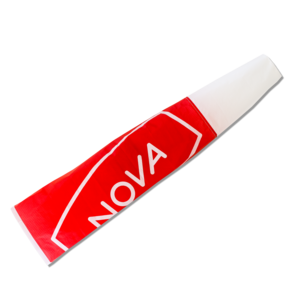 NOVA Windsack.Damit du weißt, woher der Wind kommt, legen wir einen Windsack im NOVA- Design bei. Mit einer Länge von rund 80 Zentimetern ist er groß genug für deinen Startplatz.
NOVA Windsack.Damit du weißt, woher der Wind kommt, legen wir einen Windsack im NOVA- Design bei. Mit einer Länge von rund 80 Zentimetern ist er groß genug für deinen Startplatz.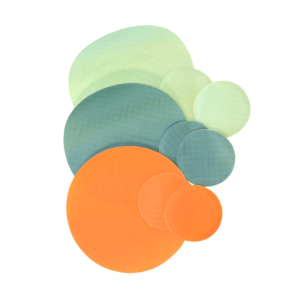 Reparatur-Set.
Reparatur-Set.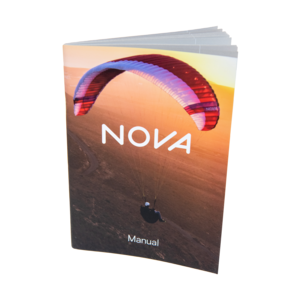 Handbuch.Im beiliegenden, sehr umfangreichen Handbuch findest du alles, was du über dein Fluggerät wissen solltest. Bitte lies es, bevor du zum ersten Mal damit fliegst.
Handbuch.Im beiliegenden, sehr umfangreichen Handbuch findest du alles, was du über dein Fluggerät wissen solltest. Bitte lies es, bevor du zum ersten Mal damit fliegst.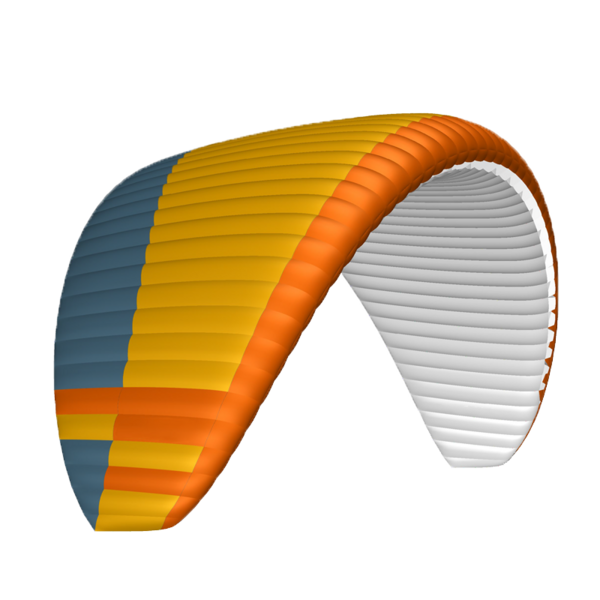 Gold
Gold
 Red
Red
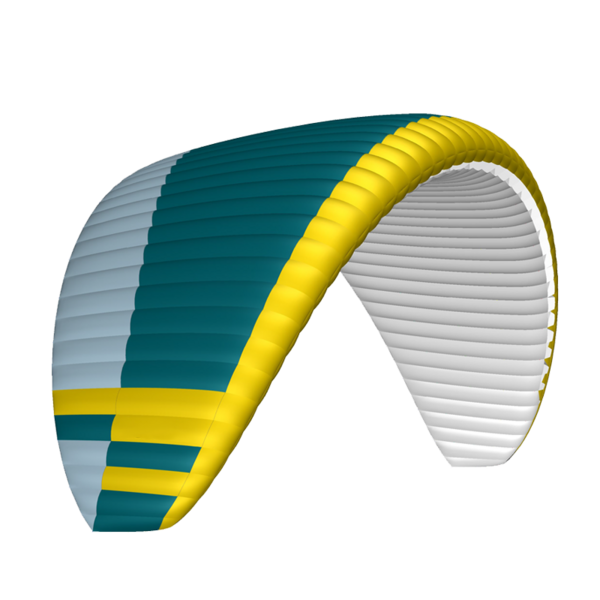 Green
Green